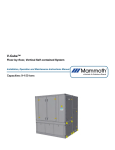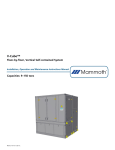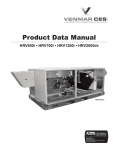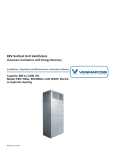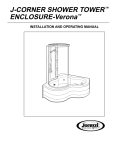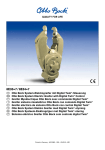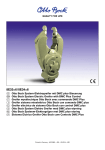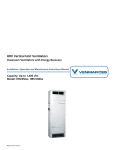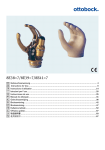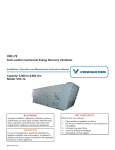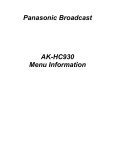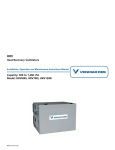Download Venmar ERV5000-10000 Instruction manual
Transcript
EnergyPack®, ERV5000–10000(i/e) and HRV3000–10000(i/e) Start-up Form and Checklist • • • • • • • IMPORTANT Complete all forms under this appendix for each unit and email, fax or mail to Venmar CES immediately after start-up to validate warranty and to provide valuable information for personnel performing future maintenance or for factory assistance to address below. Read the Installation, Operation and Maintenance Instruction Manual and the Venmar CES Control System Keypad Operation Guide and the Sequence of Operation before proceeding. Leave a copy of this report with the owner and at the unit for future reference and permanent record. To ensure proper operation of each unit, qualified personnel should perform the start-up, complete the checklist and report. All units are functionally tested except when shipped in multiple pieces. Start-up adjustments may be required. If the unit is shipped as a single piece, blowers, enthalpy wheel and compressors (if equipped) are set up to run correctly when power is connected. If any blower is running backwards or compressor is making loud noises, disconnect power and switch two leads (on three-phase power) to ensure proper rotation and avoid damage. If units are equipped with compressors, power must be turned on for 24 hours prior to a call for cooling, for the compressor crank case heaters to be energizing to prevent possible damage. The Bacview keypad located at the control panel will allow for manual override for start-up, mode of operation selection and includes an internal time clock if remote interlocks are not provided. VCES-ASTON-SF-1B – EnergyPack, ERV5000–10000, HRV3000–10000 Start-up Form Venmar CES Inc. 200 Rue Carter St. Léonard d’Aston, QC Canada J0C 1M0 Email to tech support: [email protected] Fax: 899-319-2612 Phone: 1-866-4-VENMAR Unit Identification Information Project_____________________________________________ Job Name__________________________________________ Job Address __________________________________________________ __________________________________________________ __________________________________________________ Model Number______________________________________ Serial Number_______________________________________ Tag_ ______________________________________________ Jobsite Contact_ ____________________________________ Email______________________________________________ Telephone__________________________________________ January 2014 Serial Number:______________________________________ Table E1: Pre Start-up Checklist Checklist Item 1 Check the electrical disconnect set to the ‘Off’ position. 2 Check the split section joints are properly installed on multi-sectional units. Check that all holes that have been made by the Installing Contractor after receiving the unit in the casing, partitions or floor have been well sealed to prevent air and/or water infiltration. Check the unit for obstructive packaging, objects near or in fans, dampers, energy recovery wheel, etc. 3 4 Check √ N/A a. Check that the inside of unit has been cleaned of all debris. Remove all retaining bolts on fan isolation bases. a. Check that the fan impellers are rotating freely. 5 b. Check fan impellers and drive set screws. Tighten if required. c. Check the fan bearing set screws or locking collars. Tight if required. d. Check fan belt alignment and tension. 6 7 8 9 10 e. Check the fan flexible joint connections are well attached. Check that the air filters are installed and clean. Replace if necessary. See Appendix F for optional downstream high efficiency HEPA filter installation (if supplied). a. Check all face mounted filters are attached with four clips each. b. Check each sliding filter has a retainer at the end track and well attached blank-offs. c. Check the filter pressure differential gauges, switches or sensors are free of dirt and set at a value satisfactory to the end user to trigger a filter change. Check coils if fins have been damaged in shipping, installation or building construction and are clean. Straighten fins with a fin comb and clean coil if required. a. Check all pipe connections are tight and that no damage has occurred during shipping or installation. b. Check that the piping to the coils and WSHP have been completed, piping lines have been flushed, filled, vented and tested at 1.2 times the operating pressure. Refer to Appendix B. Scroll compressor RIS vibration isolator bolts are factory tightened to the correct torque setting for operation and do not require field adjustment. a. Check the refrigerant components and piping are in good condition and have no damage or leaks from shipping or installation. b. Check that the refrigerant lines are spaced at least 1” apart and from the compressor after shipping and installation. c. Check that the refrigerant line clamps are still secure and have their rubber lining. d. Check that the clearance around the air cooled condenser is within minimum clearance and the discharge is not blocked. Check motorized damper control arms, control rods and shafts for tightness. a. Check that non motorized dampers rotate freely. Check the energy recovery wheel media for any defects from shipping or installation. See Maintenance section for details. a. Grease both pillow block bearings on the wheel(s) when grease nipples provided. b. Check that the wheel(s) are turning freely by hand and do not bind. c. Visually inspect the wheel(s) to ensure it is centered and does not tilt. If there is any indication of a problem call Venmar CES Tech Support at 1-866-4-VENMAR. d. Check that the wheel seals are properly positioned from the face of the wheel. e. Check that the wheel purge (if present) is set to the default angle as specified in the submittal. f. Check the mounting fasteners on the wheel(s) motor and gear reducer are tight. g. Check the belt and pulley on the wheel drive for correct alignment, tension and set screw tightness. 11 Check the plate media for any defects from shipping or installation. VCES-ASTON-SF-1B – EnergyPack, ERV5000–10000, HRV3000–10000 Start-up Form January 2014 Serial Number:______________________________________ Table E1: Pre Start-up Checklist Checklist Item Check √ N/A Check √ N/A Check the heat pipe fins for any fin defects from shipping or installation. 12 a. Remove retaining bolts on heat pipe tilt mechanism. b. Check the heat pipe flexible connection is properly attached and sealed on tilt mechanism. c. Check the actuator control arm and linkages are tight on tilt mechanism. 13 Check that ductwork is connected, complete and free of obstructions. 14 Check that condensate drain connections have been trapped, installed correctly and filled. Check at all unit split sections that all factory internal high and low voltage wiring connections have been properly re-connected. Check that all shipped loose or field supplied components have been correctly installed and wired. 15 16 17 18 19 20 21 22 23 24 25 26 Check that the wiring diagram has been marked up accordingly and left with the unit. Check that all power supplies and control wiring have been inspected and approved by the Local Authorities having jurisdiction. Check all factory and field wiring connections for tightness. Tighten if necessary. Check that all fuses are properly installed in holders. Check the voltage at the disconnect switch against the nameplate and against phase-to-phase readings on three-phase. If the voltage is not within 10% of rated or 2% of phase to phase, have the condition corrected before continuing start-up. Check that all field piping and venting installation and connections for heating and cooling options have been completed and tested. Set the heating and cooling enable switches to the ‘Off’ position. Refer to Appendix D for gas-fired furnace module and Appendix G for electric coil installation and maintenance and check that the installation is completed. Perform all gas-fired furnace and electric coil pre start-up checks. Check that all safety switches, overloads or other manual reset devices are reset. If the unit is equipped with compressors, power must be turned on with the unit in ‘Off’ mode for 24 hours before start-up. This will energize crank case heaters and assure no liquid refrigerant is present which could cause compressor damage or failure. Check that this has been completed. Table E2: Start-up Checklist Checklist Item 1 Before proceeding, complete the pre start-up checklist. 2 5 Check that all access panels or doors are closed. If units are equipped with compressors, feel the compressor crank cases. They should be warm if the disconnect has been ‘On’ for at least 24 hours. This will assure that no refrigerant liquid is present in the crank case which could cause compressor damage or failure to occur on start-up. Otherwise, turn the main disconnect to the ‘On’ position. The unit can be started by using the keypad and selecting the mode of operation from the Keypad Operation Guide and the Sequence of Operation. Disable the heating and cooling functions and set the unit to the occupied mode to bump start the fan wheel(s) and energy recovery wheel(s) to check their operation. Check that dampers are operating properly. 6 Check that the fan wheel(s) and energy recovery wheel(s) are rotating in the correct direction. 7 Adjust the fan motor VFD(s) to the correct air volume/Hertz. For occupied recirculation mode, adjust outside, exhaust and mixed or recirculation air damper positioners to achieve the required air volumes. Check amperage draw to each motor on each phase against motor nameplate FLA. If significantly different, check ductwork static and/or take corrective action. 3 4 8 9 VCES-ASTON-SF-1B – EnergyPack, ERV5000–10000, HRV3000–10000 Start-up Form January 2014 Serial Number:______________________________________ Table E2: Start-up Checklist 20 Checklist Item Recheck the voltage at the disconnect switch against the nameplate and against phase-to-phase readings on three-phase with all blowers operating. If the voltage is not within 10% of rated or 2% of phase-to-phase have the condition corrected before continuing start-up. Before activating the compressor on WSHP units, check that the water shut-off valves are open and water is circulating through the water-to-refrigerant heat exchanger. Check the incoming line water pressure to ensure is within design and acceptable limits. Enable the cooling mode of operation. Check if the sound of the compressor is normal or if there is excessive vibration. On units with integrated air cooled condensers check condenser fans are rotating in the correct direction. Check all field and factory refrigerant and water piping connections for leaks and correct. Operate the refrigerant system near full load conditions in both heating and cooling modes and check sub-cooling and superheat against values in Appendix P, Table P1. If readings do not match, adjust the refrigerant charge. Refer to Appendix P for information on adjusting the refrigeration charge. On units with WSHP, after a few minutes of operation: a. Check the supply discharge temperature status on the keypad for cooling air delivery. Measure the temperature difference between entering and leaving water. In cooling mode, the temperature difference should be approximately 1.5 times greater than the heating mode temperature difference. For example, if the cooling temperature difference is 15°F [8.3°C], the heating temperature difference should be approximately 7°F to 10°F [3.9°C to 5.6°C]. Alternatively, if a flow measuring valve or pressure gauge connections are included, take the flow reading or pressure drop compared to the submittal information and adjust the shut-off/balancing valve in the return line to the correct flow/pressure drop reading. b. Measure the temperature difference between entering and leaving air and entering and leaving water. With entering water of 60°F to 80°F [15.6°C to 26.7°C], leaving temperature should rise through the unit. Should not exceed 35°F [19.4°C]. If the air temperature exceeds 35°F [19.4°C], then the water flow rate is inadequate or the airflow rate may be low and a second check may be required after air flow balancing. On units with gas-fired furnace module or electric heating coils, check supply air proving interlock switch setting to ensure minimum supply airflow prior to burner operation. Set the switch to open below the minimum supply airflow on the furnace rating plate. Enable heating options, see start-up and check out instructions in Appendix D for gas-fired furnace module and Appendix G for electric coil and complete. For electric heating coil option check the amp draw on each stage, the operation of the sequence or SCR controller and the coil for any hot spots. Check the operation of the control options provided on the unit. 21 Check the setpoints on the DDC Points Reference, adjust and record changes as required. 22 Has air balancing been completed for both occupied and unoccupied operation? When unit has achieved steady state, take measurements and complete Start-up Readings portion of the Start-up Report and Checklist in Appendix E. Send a copy of the completed Start-up Report and Checklist to Venmar CES to validate warranty. Maintain a copy of the report at the unit for future reference. Once completed, return setpoints to original or required values, return the unit to the correct mode of operation and adjust the time clock if required. 10 11 12 13 14 15 16 17 18 19 23 24 VCES-ASTON-SF-1B – EnergyPack, ERV5000–10000, HRV3000–10000 Start-up Form Check √ N/A January 2014 Serial Number:______________________________________ Start-up Readings • • Allow unit to reach steady state before taking readings. Complete based on options included with unit Nameplate voltage Input voltage L1–L2 L2–L3 L1–L3 Table E3: Start-up Readings – Supply Fan Rotation Correct Full Load Amps (Nameplate Amps) Amp Draw L1 L2 L3 O/L Amp Setting Hertz RPM L3 O/L Amp Setting Hertz RPM Fan 1 Fan 2 Fan 3 Fan 4 Fan 5 Fan 6 Fan 7 Fan 8 Fan 9 Fan 10 Fan 11 Fan 12 Table E4: Start-up Readings – Exhaust Fan Rotation Correct Full Load Amps (Nameplate Amps) Amp Draw L1 L2 Fan 1 Fan 2 Fan 3 Fan 4 Fan 5 Fan 6 Fan 7 Fan 8 Fan 9 Fan 10 Fan 11 Fan 12 VCES-ASTON-SF-1B – EnergyPack, ERV5000–10000, HRV3000–10000 Start-up Form January 2014 Serial Number:______________________________________ Table E5: Start-up Readings – Condenser Fan Rotation Correct Amp Draw Full Load Amps (Nameplate Amps) L1 L2 L3 O/L Amp Setting Fan 1 Fan 2 Fan 3 Fan 4 Fan 5 Fan 6 Fan 7 Fan 8 Fan 9 Fan 10 Fan 11 Fan 12 Fan 13 Fan 14 Fan 15 Fan 16 Table E6: Start-up Readings – Compressors Full Load Amps (Nameplate Amps) Amp Draw L1 L2 L3 After compressor has been running for 15 minutes check the following: Outdoor Hot Gas Ambient Temp. Suction Discharge Liquid During AC Superheat Bypass Pressure Pressure Subcooling Cooling Functioning Start-up (°F/°C) Compressor 1 Compressor 2 Compressor 3 Compressor 4 Compressor 5 Compressor 6 Compressor 7 Compressor 8 Compressor 9 Compressor 10 Compressor 11 Compressor 12 Compressor 13 Compressor 14 Compressor 15 Compressor 16 VCES-ASTON-SF-1B – EnergyPack, ERV5000–10000, HRV3000–10000 Start-up Form January 2014 Serial Number:______________________________________ Table E7: Start-up Readings – WSHP Waterside Cooling Mode Entering Leaving Temp. Temp. Temp. Difference (°F/°C) (°F/°C) (°F/°C) Entering Temp. (°F/°C) Leaving Temp. (°F/°C) Waterside Heating Mode Temp. Entering Leaving Difference Pressure Pressure (°F/°C) (PSI) (PSI) US GPM Condenser 1 Condenser 2 Condenser 3 Condenser 4 Condenser 5 Condenser 6 Condenser 7 Condenser 8 Condenser 9 Condenser 10 Condenser 11 Condenser 12 Condenser 13 Condenser 14 Condenser 15 Condenser 16 Table E8: Start-up Readings – Electric Heating Coil Stage L1 Amps L2 Amps L3 Amps Check for Hot Pots 1 2 3 4 5 6 Table E9: Start-up Readings – Energy Recovery Wheel (ERW) Full Load Amps (Nameplate Amps) Amp Draw L1 L2 L3 O/L Amp Setting ERW 1 ERW 2 ERW 3 ERW 4 VCES-ASTON-SF-1B – EnergyPack, ERV5000–10000, HRV3000–10000 Start-up Form January 2014 Serial Number:______________________________________ Table E10: Start-up Readings – Gas-fired Duct Furnace Fuel Combustion air fan Induced draft fan motor Low fire High fire Natural Gas Propane Rotation correct2 Full load amps (nameplate amps)2 Amp draw L1/L2/L32 O/L amp setting2 Rotation correct Full load amps (nameplate amps) Amp draw L1/L2/L3 O/L amp setting Inlet gas pressure – ” w.c. Regulator outlet pressure – ” w.c. Manifold press – ” w.c. Stack CO2 – %2 Stack O2 – %2 Net stack temperature – °F/°C2 Efficiency – %2 Flame signal – mA/VDC Supply air inlet temperature – °F/°C Supply air discharge temperature – °F/°C1 Supply air temperature rise – °F/°C Inlet gas pressure – ” w.c. Regulator outlet pressure – ” w.c.2 Manifold press – ” w.c. Stack CO2 – %2 Stack O2 – %2 Net stack temperature – °F/°C2 Efficiency – %2 Flame signal – mA/VDC Supply air inlet temperature – °F/°C Supply air discharge temperature – °F/°C1 Supply air temperature rise – °F/°C Furnace #1 Furnace #2 1.Measure downstream where temperature is even in duct. 2.For IG series drum and tube gas-fired duct furnace models only. This unit has been checked out and started according with the above procedures and completed forms and is operating satisfactorily. After 24 hours of satisfactory operation shut down the unit and check all foundation bolts, shaft bearings, drive set screws, valve train and terminals. Tighten where required. Additional Comments: __________________________________________________ __________________________________________________ __________________________________________________ __________________________________________________ __________________________________________________ __________________________________________________ __________________________________________________ VCES-ASTON-SF-1B – EnergyPack, ERV5000–10000, HRV3000–10000 Start-up Form Start-up By_________________________________________________ Company Name_____________________________________ Date_______________________________________________ Email______________________________________________ Telephone__________________________________________ Email to tech support: [email protected] or Fax to: 819-399-2612. January 2014








